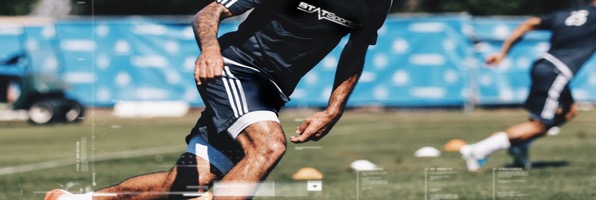
15 Aug Frequency and Duration of High Intensity Bursts in Hurling Match Play
Introduction
Hurling, like many field sports, is an intermittent sport in nature comprising of low intensity activity, interspersed with bouts of high intensity activity.
The physicality of the sport has developed in recent years at a similar rate to that of other field sports with greater emphasis being placed on strength and power [1]. Research using GPS has previously revealed positional differences in physical outputs during hurling match play [2], a finding that has been repeated in other field sports.
Performance metrics investigated to date include total distance, high speed running, sprint distance and metres per min [3] as well maximal running intensities during elite hurling match play [4].
However, the frequency and duration of grouped high intensity actions has not been extensively detailed and may provide useful insights into physical outputs of key moments during hurling match play that may otherwise be overlooked.
With the STATSports APEX software, there is a feature for such important instances named High Intensity Bursts.
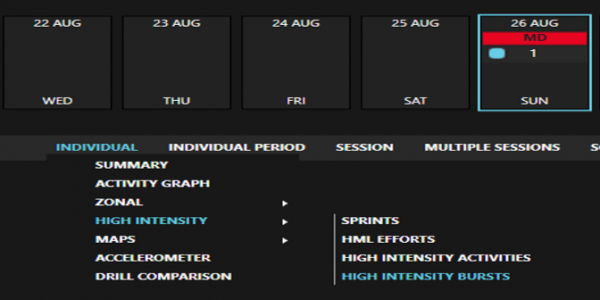
The High Intensity Burst (HIB) feature is a metric that can be used to quantify the frequency and duration of high intensity activity during a selected period (e.g. 1st Half or Small Sided Games drill). By default, for a HIB to be recognised, a minimum of three high intensity activities are required to occur within 20 seconds of each other. These high intensity activities are;
- accelerations ≥ 4 m/s2 – (default Z5)
- decelerations ≥ 4 m/s2 – (default Z5)
- and impacts ≥ 11G – (default Z5)
- Sprints
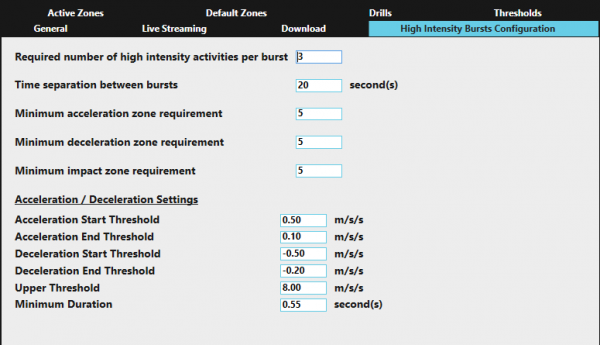
The requirements for a HIB can be adjusted to the practitioner’s preferences or even depending on the demands of the sport.
The HIB feature is fully customizable allowing the practitioner to choose not only the number of high intensity activities required and time between, but also the magnitude of the named metrics. Furthermore, the software allows you to get a detailed description of the duration of each individual high intensity burst and the time since the last burst. This can bring insights into recovery periods between these intense efforts.
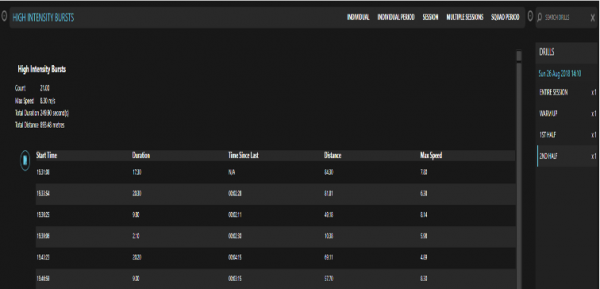
Participants
Players (n = 10/29) from an inter county hurling panel were tracked during the 2018 senior hurling championship season.
Data were only included if a full match (n = 3) was completed (70mins). Participants were categorised by their playing position: full backs (n = 2), half backs n = 2, midfielders n = 2, half forwards: n=2 and full forwards: n = 2.
Design
Players’ performances were each recorded during match play using 10-Hz GPS (STATSports APEX, Firmware 2.45). Through the APEX Software (v. 3.0.07101), the High Intensity Bursts feature provided a comprehensive breakdown of each ‘High Intensity Burst’ for the activity period selected (e.g. 1st and 2nd Half). In the software a ‘High Intensity Burst’ requires a minimum of 3 high intensity activities (acceleration ≥ 4 m/s2, deceleration ≥ 4 m/s2 and impacts ≥ 11G) per burst with a time separation of 20 seconds between bursts. This can be configured to the practitioner’s preferences. The total count, max speed achieved, total duration and total distance covered during each ‘High Intensity Burst’ is then specified. This was exported to a standardised CSV for further analysis in Microsoft Excel.
Results
The analysis revealed unique patterns of high intensity activity that can be attributed to different lines of play.
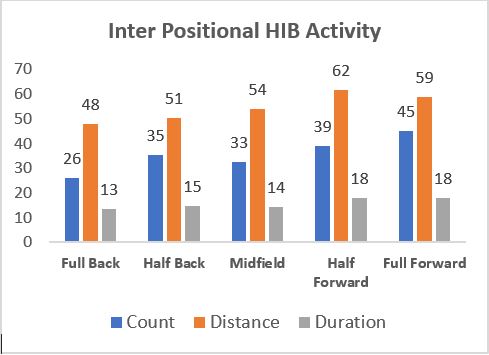
Figure 1. Inter positional comparisons for High Intensity Burst Activity
Table 1 below shows a complete breakdown with Full Forwards typically completing the greatest number of High Intensity Bursts (45 ± 6.9), Half Forwards covering the most distance in a High Intensity Burst activity (61.6m ± 10.1m) and Half Forward and Full Forward HIB activity lasting the longest (17.9 ± 3.3 and 17.9 ± 1.6 respectively).
Table 1. Count, duration and distance for HIB activity of elite senior hurlers by position (± SD)
| Position | HIB Count | HIB Duration (s) | HIB Distance (m) |
| Full Back | 26 ± 4 | 13.4 ± 0.9 | 48 ± 7.6 |
| Half Back | 35.2 ± 1.1 | 14.7 ± 1.6 | 50.5 ± 6.4 |
| Midfield | 32.5 ± 11.6 | 14.7 ± 1.6 | 50.5 ± 6.4 |
| Half Forward | 39 ± 5.6 | 17.9 ± 3.3 | 61.6 ± 10.1 |
| Full Forward | 45 ± 6.9 | 17.9 ± 1.6 | 58.6 ± 0.3 |
Practical Applications
The High Intensity Burst function can be utilised to quantify not only the number of bursts with high intensity activity a player undertook throughout a game but also the very composition of these bursts (i.e. consecutive high intensity accelerations and decelerations, their respective magnitudes, frequency and duration).
With this information, even the density of such activities can be better understood as the time stamp can reveal the time difference between respective bursts throughout a drill or game. As a result, recovery periods between such efforts can be detailed and work to rest ratios calculated.
An athlete’s ability to repeat high intensity efforts has been cited as a key component to intermittent team sports performance [5] emphasising the value of this metric in the athlete’s physical preparation.
This will allow practitioners to use this information to make better decisions in their programme design and implementation.
With noticeable inter-positional differences, one recommendation would be to consider the physical output data and how it can be translated into drill construction, specifically combination drills where a number of positions can be simultaneously conditioned in conjunction with game and position specific technical work involving the sliotar.
If you’re interested in what you’ve just read, why not request a demo here.
Author Details
David O’Donovan
Sports Scientist
References
- McIntyre M. C. (2005). A comparison of the physiological profiles of elite Gaelic footballers, hurlers, and soccer players. Br J Sports Med 39: 437-439
- Collins K., McRobert A., Morton P., O’Sullivan D., and Doran D. (2017). The Work-Rate of Elite hurling Match-Play. J Strength Cond Res
- Collins, D. K., McRobert, A., Morton, J. P., O’sullivan, D., & Doran, D. A. (2018). The work-rate of elite hurling match-play. The Journal of Strength & Conditioning Research, 32(3), 805-811.
- Young, D., Malone, S., Beato, M., Mourot, L. A. U. R. E. N. T., & Coratella, G. (2018). Identification of Maximal Running Intensities During Elite Hurling Match-Play. The Journal of Strength & Conditioning Research.
- Austin, D. J., Gabbett, T. J., & Jenkins, D. J. (2011). Repeated high-intensity exercise in a professional rugby league. The Journal of Strength & Conditioning Research, 25(7), 1898-1904.